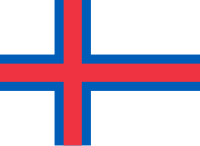
Back علم جزر فارو Arabic Kobér Kapuloan Faroe BAN Сцяг Фарэрскіх астравоў Byelorussian Сьцяг Фарэрскіх астравоў BE-X-OLD Национално знаме на Фарьорските острови Bulgarian Zastava Farskih ostrva BS Bandera de les illes Fèroe Catalan Faerská vlajka Czech Baner Ynysoedd Ffaröe Welsh Færøernes flag Danish
| Bandeira das Illas Feroe | |
|---|---|
 | |
| Características | |
| Uso | |
| Proporción | 8:11 |
| Adopción | 23 de marzo de 1948 |
| Cores | Azul Branco Vermello |
A bandeira das Illas Feroe, tamén coñecida como Merkið en feroés, que significa "a bandeira", consiste dunha cruz nórdica de cor vermella perfilada en azul sobre un pano de cor branca. É semellante ao deseño doutras bandeiras nórdicas, unha tradición estabelecida pola Dannebrog de Dinamarca,[1][2] da cal as Illas Feroe son un territorio autónomo.[3]
As proporcións da cruz nórdica da bandeira son de 6-1-2-1-6 partes no ancho da bandeira e de 6-1-2-1-12 partes ao longo da bandeira.
- ↑ Andrew Evans (2008). Iceland. Bradt. ISBN 9781841622156. Consultado o 2007-12-31.
Legend states that a red cloth with the white cross simply fell from the sky in the middle of the 13th-century Battle of Valdemar, after which the Danes were victorious. As a badge of divine right, Denmark flew its cross in the other Scandinavian countries it ruled and as each nation gained independence, they incorporated the Christian symbol.
- ↑ The Australian Flag: Colonial Relic or Contemporary Icon. William Gaunt & Sons. 2010. ISBN 978-9004181489. Consultado o 2007-12-31.
The Christian cross, for instance, is one of the oldest and most widely used symbols in the world, and many European countries, such as the United Kingdom, Norway, Sweden, Finland, Denmark, Iceland, Greece and Switzerland, adopted and currently retain the Christian cross on their national flags.
- ↑ * Benedikter, Thomas (2006-06-19). "The working autonomies in Europe". Society for Threatened Peoples. Arquivado dende o orixinal o 2008-03-09. Consultado o 2019-08-30.
Denmark has established very specific territorial autonomies with its two island territories
- Ackrén, Maria (novembro de 2017). "Greenland". Autonomy Arrangements in the World. Arquivado dende o orixinal o 2019-08-30. Consultado o 2019-08-30.
Faroese and Greenlandic are seen as official regional languages in the self-governing territories belonging to Denmark.
- "Facts about the Faroe Islands". Nordic cooperation. Arquivado dende o orixinal o 23 de abril de 2018. Consultado o 1 de xullo de 2015.
The Faroe Islands [...] is one of three autonomous territories in the Nordic Region
- Ackrén, Maria (novembro de 2017). "Greenland". Autonomy Arrangements in the World. Arquivado dende o orixinal o 2019-08-30. Consultado o 2019-08-30.
